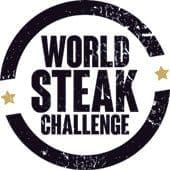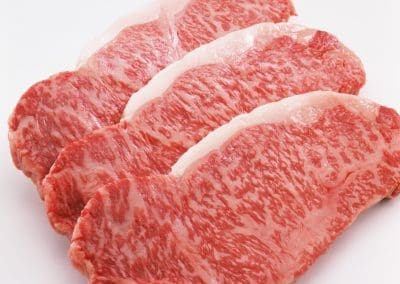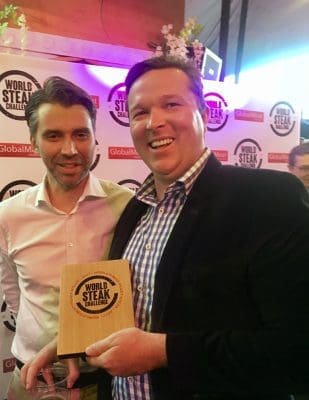AUSTRALIAN entries have earned two gold medals and a silver in the third annual World Steak Challenge held in London overnight.
While this year’s overall World’s Best Steak title went to a Polish entry, Australia scored two of the 17 gold medals awarded in the prestigious taste test competition.
 Jack’s Creek Wagyu, out of New South Wales, which claimed the overall World’s Best Steak title for the past two consecutive years, returned this year to earn gold medals for separate grain and grassfed entries.
Jack’s Creek Wagyu, out of New South Wales, which claimed the overall World’s Best Steak title for the past two consecutive years, returned this year to earn gold medals for separate grain and grassfed entries.
This year’s third annual World Steak Challenge attracted more than 100 entries from 17 countries in five continents, competing in three steak categories for rib eye, eye fillet and sirloin.
Divisional trophies were awarded for Best Grainfed and Best Grassfed steak, as well as the overall World’s Best Steak prize.
Jack’s Creek’s first gold medal came for a 30-month-old second cross Wagyu x Angus grainfed entry competing in the eye fillet class. It also collected a gold medal for a grassfed entry, second cross Wagyu x Angus, from the sirloin division.
Jack’s Creek also earned Australia’s only silver medal among the 19 awarded, for another grainfed second cross Wagyu rib-eye entry, 30 months of age.
This year’s World Steak Challenge competition was a true ‘United Nations’ event, attracting entries from the United States, Japan, England, Poland, Northern Ireland, Germany, New Zealand, Argentina, Brazil, Austria, Sweden, Wales, Finland, Paraguay, Ireland and Spain, as well as Australia.
Breed type was reasonably widely distributed among the 37 gold and silver medal winners, although there was a trend towards Angus or Angus infused entries (seven medalists); Shorthorn or Shorthorn cross (six medalists, or eight if two British Longhorn entries are included); and Wagyu or Wagyu cross (five entries).
But equally, results continue to throw up surprises, with two medal-winning entries from Spain coming from eight and ten-year-old animals, grassfed, carrying Rubia and Gallega genetics. Parts of Spain prefer to keep beef cattle to an advanced age before slaughter, for flavour reasons. Youngest medalist was a 319 day old yearling Shorthorn entry from Scotland. More obscure breeds also popped up among medal winners, including Scottish Highland cattle, British Blue and Ayrshire (dairy derived).
 The competition was based on sirloin, rib eye and eye fillet categories, judged in both raw and cooked form by an expert panel of judges, against internationally agreed criteria.
The competition was based on sirloin, rib eye and eye fillet categories, judged in both raw and cooked form by an expert panel of judges, against internationally agreed criteria.
Judges for the blind tasting included top UK, European and Australian chefs, butchers, food writers, meat scientists, authors, and trade personnel. Included on the 32-member judging panel this year was MLA’s corporate chef, Sam Burke.
The overall World’s Best Steak winner was a surprise outcome, being entered by ABP Poland, with a grainfed Limousin cross sirloin entry, 20 months of age. Two Polish entries from ABP were judged best sirloin in the competition and best rib-eye, while Jack’s Creek earned the best eye fillet award. Polish meat is generally looked-on in the UK meat market as an inferior product, often discounted in the trade over other options, but this result may go some way to improving that reputation.
While the Polish overall winner was judged best grainfed entry in this year’s competition, best grassfed steak was a British Longhorn entry from Martins’ Meats, Gloucester, England.
Australia’s gold medal winning Jack’s Creek Wagyu product was entered through the company’s Netherlands-based EU beef importer and distributor, Albers GmbH based in Dusseldorf. The grainfed entry, also judged the competition’s best overall eye fillet, was from a marbling score 9 carcase fed 450 days.
It was produced out of David, Phillip and Patrick Warmoll’s Jack’s Creek Wagyu operations based out of northern New South Wales.

Frank Albers GmbH, and and Patrick Warmoll from Jack’s Creek after collecting their overall best eye fillet award
The Warmolls started crossing high-marbling Tajima Wagyu bulls over an Angus herd in 1991 on their properties near Breeza and Willow Tree in NSW. They have since developed a successful vertically-integrated crossbred Wagyu beef business, breeding, growing, grainfeeding, processing and marketing Wagyu beef around the world.
The company ships to more than 20 destinations worldwide including China, Indonesia, Russia, Japan, Germany, Canada, Thailand, UK, South Korea, Hong Kong, Spain, Saudi Arabia, Belgium, UAE, Switzerland, Norway, Denmark, Singapore, Vietnam, Kuwait, Bahrain, Lebanon and Qatar.
Jack’s Creek produces a range of F1-F4 Wagyu cattle, carrying strong Tajima genetic influence. It gets its service kill done at the Northern Cooperative Meat Co plant at Casino in northern NSW – recognised as a specialist in processing Wagyu carcases, providing service kills for some of Australia’s best known Wagyu supply chains.
The company’s grainfed entries winning entry started on a wheat-based ration (including corn homily), before graduating over the last 100 days onto a corn and corn homily-based ration, giving a unique flavour profile and optimising marbling.
Other gold medalists this year came from the US, Spain, England, Northern Ireland, Poland, Brazil (JBS), Scotland, Ireland and Finland.
The World Steak challenge is designed to provide a platform for countries and steak producers to benchmark their steak production against international competitors and use the publicity and recognition that it generates to promote their exports on the world stage.
Event organiser, Reed Publishing, said the event also provided an opportunity to engage with consumers to celebrate the joy and benefits of eating steak as part of a healthy balanced diet and highlight the quality and standards of steak production around the globe.
The high quality of entries this year was a testament to the hard work put in by beef producers around the world, organisers said.
“The fact we had so many more entries this year highlights the pride that they take in their product and the eagerness to win such an accolade. For a producer to retain the title of World’s Best Steak is an amazing achievement and shows a high level of consistency in production.”
- This item will be updated with more detail and photos as further information comes to hand this morning.

For your info English Longhorn are unrelated to Shorthorns, they have more genetic linkage to Red Angus and Hereford in fact.
Thanks for the update Richard. Our mistake. We saw a few at the Royal Agricultural Show in Carincester UK back in the 1990s. Had markings and colouring very similar to roan Shorthorns, so we might have jumped to conclusions. From memory lots of loose scurrs amongst them. Large framescore cattle back then, perhaps made them a bit extreme for large parts of Australia, we concluded, but visually impressive, nonetheless. We note you have been behind the importation of a few – do they marble, we wonder? Editor